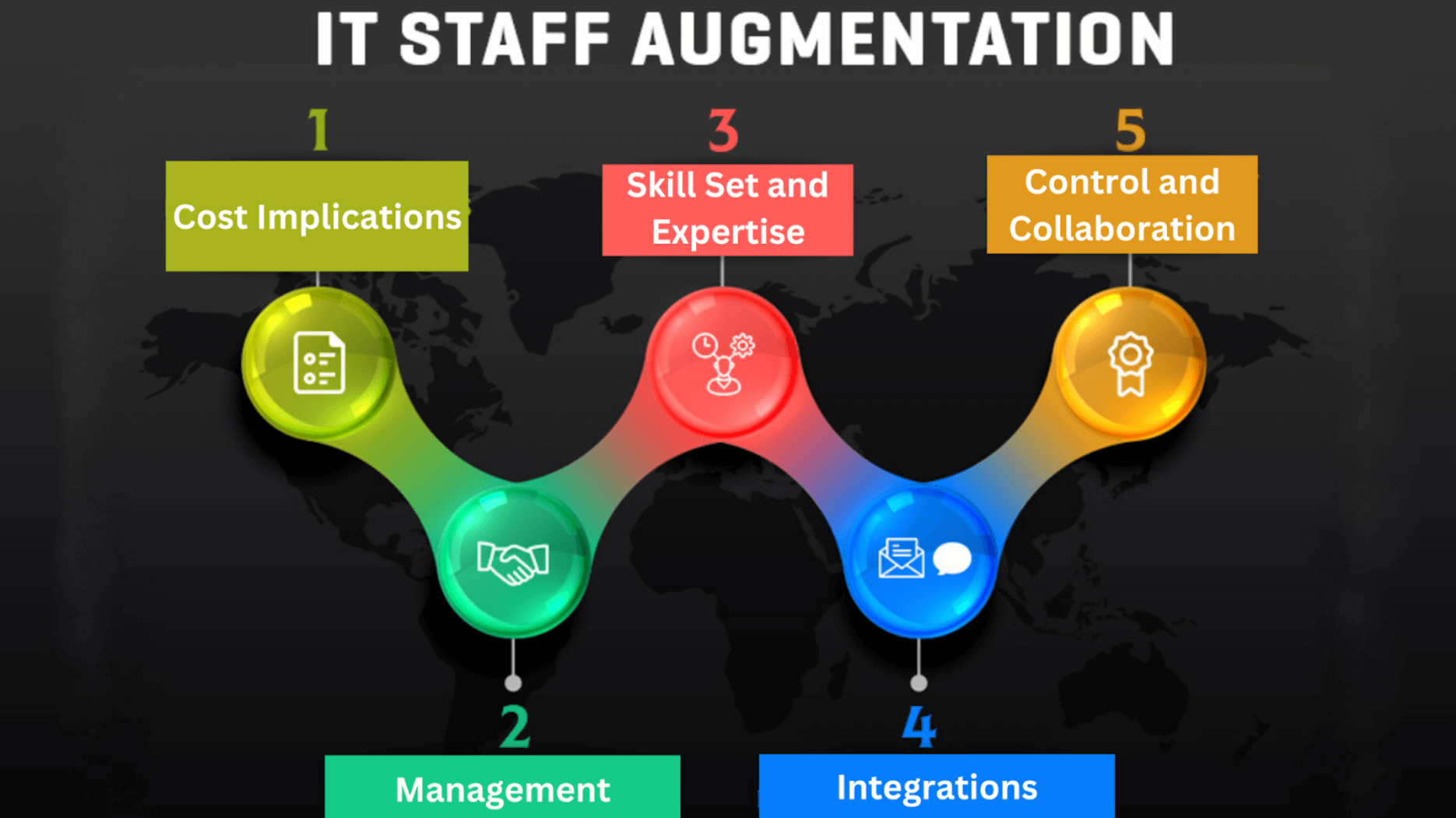In the ever-evolving world of technology, it might not be possible for companies to have personnel equipped with the latest technological advancements. Here's where concepts like staff augmentation and outsourcing come in.
Through staff augmentation services and outsourcing, companies can help fulfill the needs of their clients without compromising on efficiency. However, both staff augmentation and outsourcing differ from each other.
Staff augmentation is referred to hiring appropriate talents on a contractual basis for a particular project. Whereas outsourcing is delegating the functioning and work of your organization to another firm or group of individuals.
We have created this detailed blog to help you understand staff augmentation and outsourcing in a better manner.
Definition of Staff Augmentation and Outsourcing
First, before elaborating on their particulars, the definitions of staff augmentation and outsourcing must be understood.
Staff augmentation is a temporary staffing model that allows enterprises to recruit temporary external personnel to work together with existing team members, usually on a short-term basis. These external personnel are usually specialists whose skills are required to fill a talent gap for specific projects, functions, or departments.
In contrast, outsourcing is the process of hiring an external company or vendor to perform a certain business function or provide a service—usually on a long-term contract. The outsourcing company is responsible for managing the entire process, and overseas employees will integrate into the outsourcing company's own teams but not into your team.
Both strategies can be used to bridge a gap in the workforce. However, the operational differences, degree of control offered, and effects on team chemistry and dynamics are significant.
Why Choosing the Right Strategy is Crucial for Growth
This is the choice of staff augmentation vs outsourcing that is no singular solution. The choice fundamentally hinges on the goals of your company, the skill sets required, the scale of the project, and your own ability to oversee an outside workforce. For instance, if enhancement to a project requiring specialized capabilities for a predetermined period was being carried out, staff augmentation would be appropriate. By contrast, if the business functions outsourced are merely noncore ones, outsourcing would be more appropriate.
Most importantly, you must analyze the merits and demerits of both approaches for the sake of a right choice, so your business can be flexible and economical and focus on growth in the long run.
What is Staff Augmentation?
Staff augmentation is a dynamic workforce strategy that allows businesses to fill skill gaps on a temporary basis with external specialized talent, usually in the form of contractors or freelancers. In contrast to outsourcing, where an entire function is delegated to a third-party service provider, staff augmentation is about supplementing your existing team with just the right people at just the right time.
When businesses seek staff augmentation services, they often partner with specialized agencies that can provide the best talent suited for their specific project requirements. This model allows for faster resource acquisition without the long-term commitments involved in hiring permanent staff.
How Staff Augmentation Works
When staff augmentation is involved, a company engages an agency or service provider to locate professionals with the skills needed. These professionals work alongside the client's internal teams, following client processes, working on client systems, and reporting to in-house managers.
This model is flexible, as the companies can ramp up or down depending on the need of the project. The augmented workers are usually there for a specific engagement or a fixed period and are expected to acclimatize themselves within the existing team.
Key Benefits of Staff Augmentation
- Flexibility and scalability: You can rapidly rescale the number of members in your team in response to the immediate requirements of the project.
- Access to specialized skills: Staff augmentation services enable the hiring of market talent with unique skill sets, which may be hard to find or maintain under regular employment.
- Reduced time for market: With the involvement of external experts, the project timelines can be drastically shortened and bottlenecks are avoided.
- Greater control: You control the day-to-day management of the project, along with its further integration with your internal team.
When to Choose Staff Augmentation
Staff augmentation is most appropriate in situations in which enterprises require specialist expertise for a limited time but still wish to have stringent control over project and team.
Common scenarios include:
- Software development projects
- Upgrades to IT systems
- Engineering activities
- Design and marketing campaigns
- Short-term assignments that are highly specialized but require no long-term commitment
What is Outsourcing?
Unlike staff augmentation, outsourcing refers to the hiring of an external company for execution of an entire business function or process, usually under longstanding arrangements. This may pertain to customer service, IT management, payroll processing, or product manufacturing. The outsourcing company is usually responsible for running the operation as prescribed for the outsourced function and is, therefore, able to free the business for concentrating on its core activities.
Outsourcing is typically a more permanent solution, where an external company takes on key operational tasks for the organization, allowing internal teams to focus on strategic activities.
Comparing Outsourcing with Staff Augmentation
There are some differences between outsourcing and staff augmentation:
- Responsibility: In outsourcing, full responsibility for service delivery lies with the external organization, whereas day-to-day management is assumed by the outfit in staff augmentation.
- Scope: Outsourcing works for the entire function or process, whereas staff augmentation is for filling temporary talent gaps within an existing team.
- Long-Term Commitment: Traditionally, outsourcing will enact a long-term relationship, and staff augmentation would be considered more temporary and project-based.
Benefits of Outsourcing for Business Operations
- Cost Saving: The outsourcing functions are labor-intensive, and thus their transfer to other vendors will imply great savings on the operational costs.
- Efficiency: Companies outsourced to have effective specialization, which in turn brings about efficiency with expertise.
- Focus on Core Activities: Businesses can concentrate more on strategic growth and key operations by outsourcing non-core activities.
- Risk Management: With regard to compliance, security, and regulatory matters, outsourcing allows the business to transfer some of the risk to the outsourcing provider.
Scenarios Best Suitable for Outsourcing
It is good outsourcing for those industries that require cost-effective large-scale services and do not need maintenance. The most common outsourcing scenarios include:
- Call center operations and Customer support
- Payroll and HR management
- Accounting and Financing
- IT support and Infrastructure management
- Manufacturing and Supply chain management
Staff Augmentation vs Consulting
When deciding between staff augmentation vs consulting, it is important to understand the distinctions between these two models. Consulting often involves bringing in an expert to advise on a particular aspect of a business strategy or problem, while staff augmentation focuses on temporarily increasing workforce capacity with specialized talent for specific projects.
Consulting typically focuses more on advice and analysis, whereas staff augmentation is geared toward hands-on execution, adding talent to your team on a short-term basis. This makes staff augmentation vs consulting a choice based on whether you need advice or additional operational capacity.
Comparing Staff Augmentation vs Outsourcing
It is imperative that the organization fully understand the differences between staff augmentation and outsourcing before making the right choice for the organization. Let's break it down further.
Flexibility
The key difference in the models is business flexibility. Staff augmentation is totally flexible on the ground that you are managing the whole team, and you can scale or de-scale the team with members as you see fit.
Also, in most cases, outsourcing often tends towards having a fixed arrangement with a third-party vendor for a long time that is inflexible in the short-term.

Cost Implications
Staff augmentation totals up to a larger amount because the company avails of the highly specialized skills for a very short while. One hires talent only for the time one needs him or her at the company.
Outsourcing may appear cheaper in terms of the labor costs of casual personnel when it comes to the non-core functions, but that’s when all its concealed costs in vendor management, quality control, and lesser oversight will start.
Skill Set and Expertise
Staff augmentation allows businesses to match narrow and very specific requirements to specialized talent, and it works best for projects that require unique expertise.
On the other hand, outsourcing provides wider skill sets out to the outsourcing institution's team but not really ‘crafted to fit’ the company's needs.
Control and Collaboration
Staff augmentation provides companies with much greater control over their projects and joint ventures with staff augmentation, which encourages great integration and direct communication.
When a function or process is outsourced, the vendor assumes responsibility for managing that aspect for a business and thus mostly loses control.
When to Choose Staff Augmentation
The preferred circumstances for staff augmentation are in short-term efforts of specialized talent on a very specific task. Here are some examples:
- Technology development (software, mobile apps)
- Business expansion
- Any special project with a timeframe assigned to it
Management and Integration of Augmented Staff into Your Team
For the successful integration of augmented staff, emphasis on communication, definition of expectations, and inclusion in team activities are a must. Onboarding training and the appropriate set of collaboration tools are also indispensable.
Critical Staff Augmentation Issues and Their Solutions
An issue could be the leadership and integration of remote staff into an existing team. Strong leadership, prompt or constant communication, and project-management tools that assist collaboration will provide mitigation.
When to Choose Outsourcing
Outsourcing is ideal for non-core business functions that do not require daily monitoring, such as:
- Customer service
- IT infrastructure
- Marketing campaigns
Effectively Managing Outsourced Teams
Managing outsourced teams requires precision by ensuring the contracts are clear, communication is effective, and expectations are set. Regular check-ins and detailed performance metrics could ensure success.
Common Pitfalls and How to Avoid Them in Outsourcing
Some common pitfalls include poor communication, loss of control over quality, and cultural diversities. Clearly defined guidelines and proper monitoring would help in overcoming these issues.
Impact on Business Growth
On-site staff augmentation and outsourcing can provide varying degrees of scalability and efficiency. Staff augmentation facilitates quicker project delivery, while outsourcing eases operational burdens. In the long run, outsourcing allows companies to focus on core business activities while staff augmentation keeps high-level expertise on standby whenever required.
Cost Comparison
Both approaches are nothing more than expensive forms of achieving goals; augmenting staff may seem more expensive due to the hourly charges, but it offers more touch and personalized skills. Outsourcing would be considered to give a better return on investment for something a non-core function may require more time for coordination with the vendor.
Conclusion
Staff augmentation and outsourcing are two important tools for business growth, but finding the right choice would depend on your individual specifics. Staff augmentation allows for flexibility, control, and specialized expertise, while outsourcing can help you cut costs and scale up noncore functions. Understanding your business goals, project scope, and internal capabilities will funnel the choice between staff augmentation and outsourcing as the better route for you to scale your workforce and grow your business.
If you are seeking outsourcing or staff augmentation services, contact BestPeers. We have a skilled team of professionals who will help you complete your tasks with efficiency. Schedule an appointment with us and get the best personnel onboard for your requirements.




